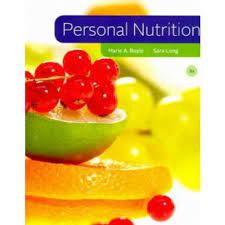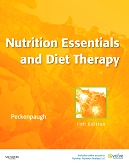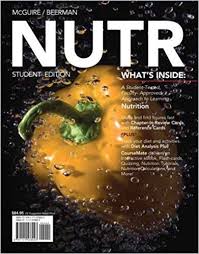Test Bank For Personal Nutrition 8th Edition by Marie A
Original price was: $65.00.$30.00Current price is: $30.00.
Test Bank For Personal Nutrition 8th Edition By Marie A is an excellent book for those who are looking to better their personal nutrition. This book provides valuable information on how to create a healthy diet, how to shop for healthy foods, and how to cook meals that are nutritious and delicious. Test Bank For Personal Nutrition 8th Edition By Marie A is an essential guide for anyone who wants to improve their overall health and well-being.
With clear and concise instructions, Test Bank For Personal Nutrition 8th Edition By Marie A is a must-have for anyone who is serious about making positive changes to their diet. Test Bank For Personal Nutrition 8th Edition by Marie A is available now. Order your copy today!
Digital item No Waiting Time Instant Download
ISBN-13: 978-1111571139 ISBN-10: 1111571139
Description
Test Bank For Personal Nutrition 8th Edition by Marie A
Test Bank for Personal Nutrition 8e
Chapter 3 – Anatomy for Nutrition’s Sake
Question information key:
ANS = correct answer; REF = textbook page reference; TOP = question topic
Multiple Choice
1. Another term for amylase is _____.
a. bile
b. ptyalin
c. chyme
d. bicarbonate
e. mucus
ANS: b REF: 75 TOP: The Digestive System—The Mouth
2. What may happen if the lower esophageal sphincter is not closed tight enough after eating?
a. Heartburn
b. High blood pressure
c. Burping
d. Hiccups
e. Diarrhea
ANS: a REF: 79 TOP: The Digestive System—The Esophagus
3. The digestion of which nutrient occurs in the stomach?
a. Vitamin B12
b. Lactose
c. Water
d. Protein
e. Fiber
ANS: d REF: 78 TOP: The Digestive System—The Stomach
4. Which of the following controls the flow of chyme into the small intestine?
a. Lower esophageal sphincter
b. Pyloric sphincter
c. Ileocecal valve
d. Oral cavity
e. Cortex
ANS: b REF: 76 TOP: The Digestive System—The Stomach
5. Which substance neutralizes stomach acid as chyme enters the small intestine?
a. Amylase
b. Pepsin
c. Bile
d. Bicarbonate
e. Glycogen
ANS: d REF: 79 TOP: The Digestive System—Small Intestine
6. Which nutrient stimulates peristalsis when present?
a. Protein
b. Fiber
c. Vitamins
d. Starch
e. Fat
ANS: b REF: 79 TOP: The Digestive System—Small Intestine
7. All of the following are examples of the smaller units that larger nutrients are broken down into except:
a. proteins.
b. glycerol.
c. fatty acids.
d. amino acids.
e. glucose.
ANS: a REF: 79 TOP: The Digestive System—Small Intestine
8. What is left after the digested mixture reaches the end of the small intestine?
a. Dissolved minerals
b. Glucose
c. Amino acids
d. Vitamins
e. Fat
ANS: a REF: 80 TOP: The Digestive System—Small Intestine
9. Which of the following is present in feces?
a. Water
b. Bile pigments
c. Bacteria
d. Fiber
e. All of the above
ANS: e REF: 82 TOP: The Digestive System—Large Intestine
10. Joe finds himself troubled with gas after eating certain foods. Which is not true about intestinal gas?
a. It comes directly from the food.
b. Another name for it is “flatus.”
c. It is produced from bacterial fermentation.
d. The quantity of the gas depends on the types of foods eaten.
e. The quality of the gas depends on the types of foods eaten.
ANS: a REF: 82 TOP: The Digestive System—Large Intestine
11. Susan had her gallbladder removed. Which of the following substances will she no longer store there?
a. Amylase
b. Bile
c. Bicarbonate
d. Water
e. Glycogen
ANS: b REF: 83 TOP: The Digestive System—Accessory Organs
12. Which chemical stimulates the gallbladder to send bile into the small intestine?
a. Cholecystokinin
b. Bicarbonate
c. Lycopene
d. Linoleic acid
e. Hydrochloric acid
ANS: a REF: 83-84 TOP: The Digestive System—Accessory Organs
13. Which of the following is an endocrine function of the pancreas?
a. To secrete enzymes that break down proteins
b. To secrete bicarbonate
c. To secrete amylase
d. To secrete insulin
e. All of the above are endocrine functions
ANS: d REF: 84 TOP: The Digestive System—Accessory Organs
14. All nutrients leaving the digestive system are taken to the _____.
a. pancreas
b. large intestine
c. liver
d. gallbladder
e. stomach
ANS: c REF: 84 TOP: Metabolism
15. Joe is taking a nutrition course and is told that the galactose in his milk ends up as glucose. Where does this conversion take place?
a. Brain
b. Liver
c. Gallbladder
d. Appendix
e. Pancreas
ANS: b REF: 84-85 TOP: Metabolism
16. Which of the following is not a possible fate for amino acids in the liver?
a. They are converted to glucose.
b. They are converted to fat.
c. They are converted to vitamin D.
d. They are converted to another amino acid.
e. All of these are possible fates for amino acids.
ANS: c REF: 85 TOP: Metabolism
17. Excess glucose in the body is converted to _____.
a. fat only
b. amino acids only
c. glycogen only
d. fat and glycogen
e. cholesterol and glucagons
ANS: d REF: 84-85 TOP: Metabolism
18. Glycogen provides the body with glucose under which circumstance?
a. Eating excess calories
b. Eating too many carbohydrates
c. When glucose absorbed from ingested foods is used up
d. When a person has high blood pressure
e. When the fat content of a person’s diet is elevated
ANS: c REF: 85 TOP: Metabolism
19. Which of the following reactions is classified as anabolic?
a. Glycogen → glucose
b. Protein → amino acids
c. Triglycerides → fatty acids and glycerol
d. Glucose → glycogen
e. All of these are anabolic reactions.
ANS: d REF: 85 TOP: Metabolism
20. Which food would most likely contain conjugated linoleic acid (CLA)?
a. Milk
b. Salmon
c. Carrots
d. Multi-grain bread
e. Orange
ANS: a REF: 86 TOP: Let Foods Be Your Medicine
21. Which of the following chemicals is an emulsifier?
a. Amino acids
b. Bile
c. Amylase
d. Conjugated linoleic acid
e. Hydrochloric acid
ANS: b REF: 79 TOP: The Digestive System—Small Intestine
22. What role does bicarbonate play in digestion?
a. Digests protein in the small intestine
b. Uncoils proteins in the stomach
c. Neutralizes acid from the stomach in the small intestine
d. Aids in the absorption of vitamin B12
e. Emulsifies fat into small particles
ANS: c REF: 79 TOP: The Digestive System—Small Intestine
23. Approximately how long does it take for a meal to empty from the stomach?
a. ½ hour to one hour
b. 2 hours
c. 4 hours
d. 6 hours
e. 8 hours
ANS: c REF: 78 TOP: The Digestive System—The Stomach
24. The main site of digestion and absorption of nutrients is the _____.
a. mouth
b. stomach
c. small intestine
d. large intestine
e. liver
ANS: c REF: 78-79 TOP: The Digestive System—Small Intestine





Be the first to review “Test Bank For Personal Nutrition 8th Edition by Marie A”